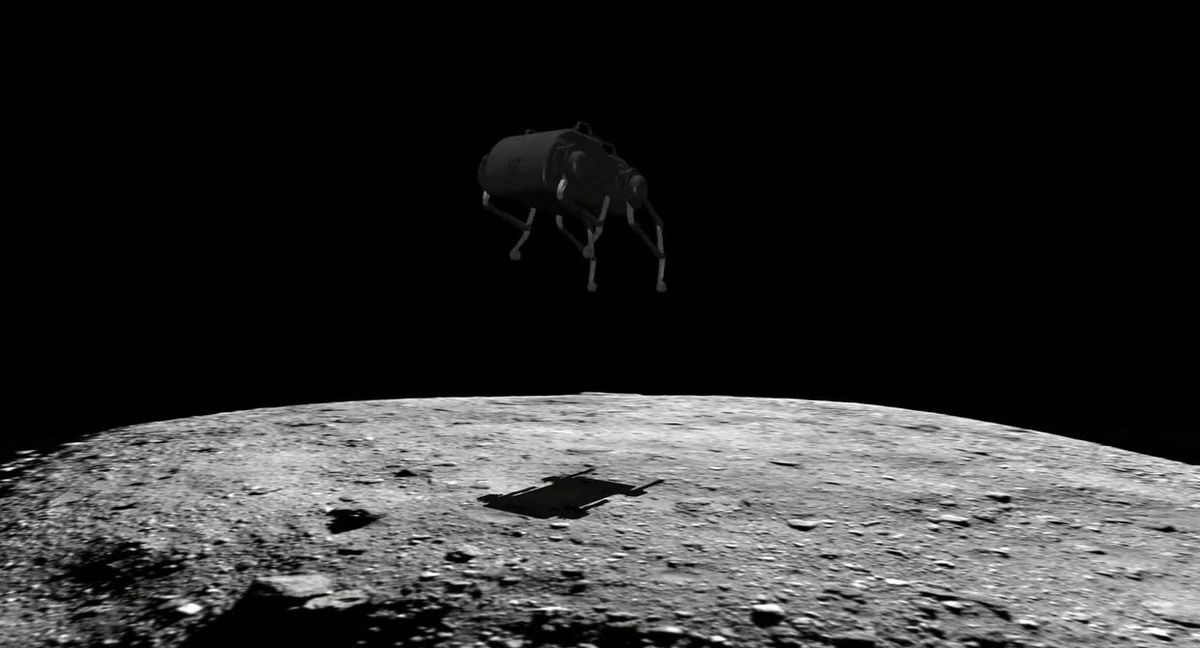Here on Earth, we’re getting good enough at legged robots that we’re starting to see a transition from wheels to legs for challenging environments, especially environments with some uncertainty as to exactly what kind of terrain your robot might encounter. Beyond Earth, we’re still heavily reliant on wheeled vehicles, but even that might be starting to change. While wheels do pretty well on the Moon and on Mars, there are lots of other places to explore, like smaller moons and asteroids. And there, it’s not just terrain that’s a challenge: it’s gravity.
In low gravity environments, any robot moving over rough terrain risks entering a flight phase. Perhaps an extended flight phase, depending on how low the gravity is, which can be dangerous to robots that aren’t prepared for it. Researchers at the Robotic Systems Lab at ETH Zurich have been doing some experiments with the SpaceBok quadruped, and they’ve published a paper in IEEE T-RO showing that it’s possible to teach SpaceBok to effectively bok around in low gravity environments while using its legs to reorient itself during flight, exhibiting “cat-like jumping and landing” behaviors through vigorous leg-wiggling.
Also, while I’m fairly certain that “bok” is not a verb that means “to move dynamically in low gravity using legs,” I feel like that’s what it should mean. Sort of like pronk, except in space. Let’s make it so!
Just look at that robot bok!
This reorientation technique was developed using deep reinforcement learning, and then transferred from simulation to a real SpaceBok robot, albeit in two degrees of freedom rather than three. The real challenge with this method is just how complicated things get when you start wiggling multiple limbs in the air trying to get to a specific configuration, since the dynamics here are (as the paper puts it) “highly non-linear,” and it proved somewhat difficult to even simulate everything well enough. What you see in the simulation, incidentally, is an environment similar to Ceres, the largest asteroid in the asteroid belt, which has a surface gravity of 0.03g.
Although SpaceBok has “space” right in the name, it’s not especially optimized for this particular kind of motion. As the video shows, having an actuated hip joint could make the difference between a reliable soft landing and, uh, not. Not landing softly is a big deal, because an uncontrolled bounce could send the robot flying huge distances, which is what happened to the Philae lander on comet 67P/Churyumov–Gerasimenko back in 2014.
For more details on SpaceBok’s space booking, we spoke with the paper’s first author, Nikita Rudin, via email.
IEEE Spectrum: Why are legs ideal for mobility in low gravity environments?
Rudin: In low gravity environments, rolling on wheels becomes more difficult because of reduced traction. However, legs can exploit the low gravity and use high jumps to move efficiently. With high jumps, you can also clear large obstacles along the way, which is harder to do in higher gravity.
Were there unique challenges to training your controller in 2D and 3D relative to training controllers for terrestrial legged robot motion?
The main challenge is the long flight phase, which is not present in terrestrial locomotion. In earth gravity, robots (and animals) use reaction forces from the ground to balance. During a jump, they don't usually need to re-orient themselves. In the case of low gravity, we have extended flight phases (multiple seconds) and only short contacts with the ground. The robot needs to be able to re-orient / balance in the air. Otherwise, a small disturbance at the moment of the jump will slowly flip the robot. In short, in low gravity, there is a new control problem that can be neglected on Earth.
Besides the addition of a hip joint, what other modifications would you like to make to the robot to enhance its capabilities? Would a tail be useful, for example? Or very heavy shoes?
A tail is a very interesting idea and heavy shoes would definitely help, however, they increase the total weight, which is costly in space. We actually add some minor weight to feet already (in the paper we analyze the effect of these weights). Another interesting addition would be a joint in the center of the robot allowing it to do cat-like backbone torsion.
How does the difficulty of this problem change as the gravity changes?
With changing gravity you change the importance of mid-air re-orientation compared to ground contacts. For locomotion, low-gravity is harder from the reasoning above. However, if the robot is dropped and needs to perform a flip before landing, higher gravity is harder because you have less time for the whole process.
What are you working on next?
We have a few ideas for the next projects including a legged robot specifically designed and certified for space and exploring cat-like re-orientation on earth with smaller/faster robots. We would also like to simulate a zero-g environment on earth by dropping the robot from a few dozens of meters into a safety net, and of course, a parabolic flight is still very much one of our objectives. However, we will probably need a smaller robot there as well.
Cat-Like Jumping and Landing of Legged Robots in Low Gravity Using Deep Reinforcement Learning, by Nikita Rudin, Hendrik Kolvenbach, Vassilios Tsounis, and Marco Hutter from ETH Zurich, is published in IEEE Transactions on Robotics.
Evan Ackerman is a senior editor at IEEE Spectrum. Since 2007, he has written over 6,000 articles on robotics and technology. He has a degree in Martian geology and is excellent at playing bagpipes.



